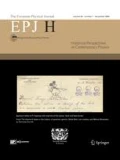Abstract
This is a tutorial for the many-worlds theory by Everett, which includes some of my personal views. It has two main parts. The first main part shows the emergence of many worlds in a universe consisting of only a Mach–Zehnder interferometer. The second main part is an abridgment of Everett’s long thesis, where his theory was originally elaborated in detail with clarity and rigor. Some minor comments are added in the abridgment in light of recent developments. Even if you do not agree to Everett’s view, you will still learn a great deal from his generalization of the uncertainty relation, his unique way of defining entanglement (or canonical correlation), his formulation of quantum measurement using Hamiltonian, and his relative state.



Similar content being viewed by others
Change history
23 March 2021
The article has has been published online first by mistake.
References
B.S. DeWitt, N. Graham (eds.), The Many-Worlds Interpretation of Quantum Mechanics (Princeton University Press, Princeton, 1973)
J.A. Barrett, P. Byrne (eds.), The Everett Interpretation of Quantum Mechanics: Collected Works 1955–1980 with Commentary (Princeton University Press, Princeton, 2012)
P. Byrne, The Many Worlds of Hugh Everett III (Oxford University Press, New York, 2010)
H. Everett, Rev. Mod. Phys. 29, 454 (1957)
J.A. Wheeler, Rev. Mod. Phys. 29, 463 (1957)
D. Deutsch, The Beginning of Infinity (Penguin Books, New York, 2011)
H. Kragh, Ann. Sci. 66, 529 (2009)
M. Tegmark, Phys. Rev. D 85, 123517 (2012)
L. Zehnder, Zeitschrift für Instrumentenkunde 11, 275 (1891)
L. Mach, Zeitschrift für Instrumentenkunde 12, 89 (1892)
P. Hariharan, Basics of Interferometry (Elsevier, Amsterdam, 2007)
R.B. Griffiths, Phys. Lett. A 178, 17 (1993)
A. Zeilinger, Am. J. Phys. 49, 882 (1981)
K.P. Zetie, S.F. Adams, R.M. Tocknell, Phys. Educ. 35, 46 (2000)
J. von Neumann, Mathematical Foundations of Quantum Mechanics (Princeton University Press, Cambridge, 1955)
J.S. Bell, Physics 1, 195 (1964)
I. Białynicki-Birula, J. Mycielski, Commun. Math. Phys. 44, 129 (1975)
Y. Zhao, B. Wu, Sci. China Phys. Mech. Astron. 62, 997011 (2019)
J. von Neumann, Zeitschrift für Physik 57, 30 (1929)
J. von Neumann, Eur. Phys. J. H 35, 201 (2010)
X. Han, B. Wu, Phys. Rev. E 91, 062106 (2015)
D. Bohm, Quantum Theory (Prentice-Hall, New York, 1951)
S. Osnaghi, F. Freitas, Jr., Stud. Hist. Philos. Mod. Phys. 40, 97 (2009)
M. Jammer, The Philosophy of Quantum Mechanics (Wiley-Interscience, New York, 1974)
S.W. Hawking, Phys. Rev. D 13, 191 (1976)
M. Gell-Mann, in Complexity, Entropy and the Physics of Information, ed. by J.B. Hartle, W.H. Zurek (Addison-Wesley, Reading, 1990), pp. 425–459
S. Carroll, Something Deeply Hidden (Dutton, New York, 2019)
Acknowledgements
This work is supported by The National Key R&D Program of China (Grants Nos. 2017YFA0303302, 2018YFA0305602), National Natural Science Foundation of China (Grant No. 11921005), and Shanghai Municipal Science and Technology Major Project (Grant No. 2019SHZDZX01).
Author information
Authors and Affiliations
Corresponding author
Appendices
Appendices
In Everett’s long thesis, there are two appendices. In the first one, Everett offered detailed proofs for many mathematical relations in the main text. In the second one, he offered his view on theoretical physics in general. Here is the summary of the second appendix.
There are a number of interpretations of quantum mechanics, most of which are equivalent in the sense that they agree with all the physical experiments. To decide among them, we must go beyond experiments and discuss the fundamental nature and purpose of physical theories.
Every theory has two separate parts, the formal part and the interpretive part. The formal part consists of a purely logico-mathematical structure that consists of a collection of symbols and rules for their manipulation. The interpretive part is a set of association rules that relate the formal symbols with the experienced world. There can be many different theories which are logical consistent and correct in explaining the perceived world. In this case, further criteria such as usefulness, simplicity, comprehensiveness, pictorability, etc., must be used to select the theory or the theories. In particular, simplicity refers to conceptual simplicity not ease in use. It is harmful to the progress of physics that a physical theory should contain no elements which do not correspond directly to what we observe.
Part IV: The legacy of Everett’s theory
Although Everett published his short thesis in Review of Modern Physics, a well-known and respected journal, along with Wheeler’s supporting article [4, 5], his theory of the universal wave function had received little attention for many years [3, 24]. In 1962, Everett was invited by Podolsky to a small workshop at Xavier University, where he lectured on his theory for the first time in public. However, this did not mean that his theory was getting wide recognition; it only showed that his work was not completely forgotten [3].
Everett’s theory began to be noticed widely in the physics community only after DeWitt started to promote it as the many-worlds theory around 1970s with Graham’s help [1, 3, 24]. As a result, Everett’s theory is now widely known as the many-worlds theory. Only a limited number of specialists know it as the theory of the universal wave function or the “relative state” formulation of quantum mechanics. Now Everett’s theory has to be mentioned in all serious discussion of the subject known as the interpretation of quantum mechanics [25].
To celebrate the 50th anniversary of its publication in 2007, the influential magazine, Nature, put the many-worlds theory on its July cover; and BBC produced a special program called “Parallel worlds, Parallel lives”. This theory is now extremely popular among non-specialists.
Among physicists, the many-worlds theory is still a minority view but it is gaining momentum. Hawking [26] and Gell-Mann [27] were famous names among its early supporters. Current influential advocates include David Deutsch [6], Max Tegmark [8], and Sean Carroll [28].
Rights and permissions
About this article
Cite this article
Wu, B. Everett’s theory of the universal wave function. EPJ H 46, 7 (2021). https://doi.org/10.1140/epjh/s13129-021-00001-0
Received:
Accepted:
Published:
DOI: https://doi.org/10.1140/epjh/s13129-021-00001-0



